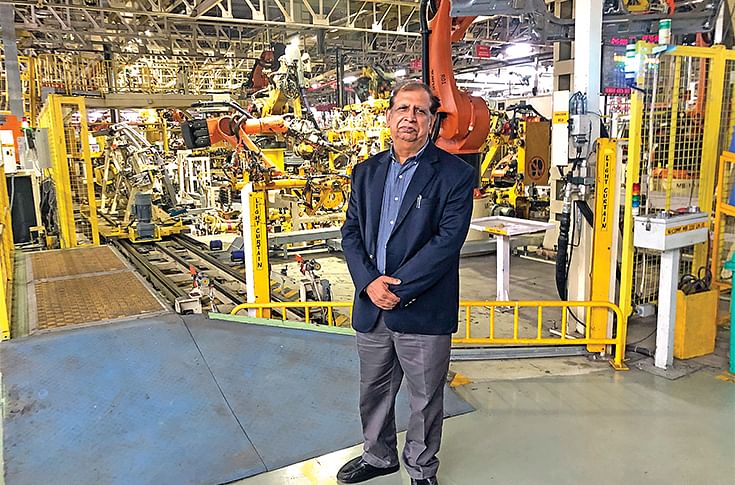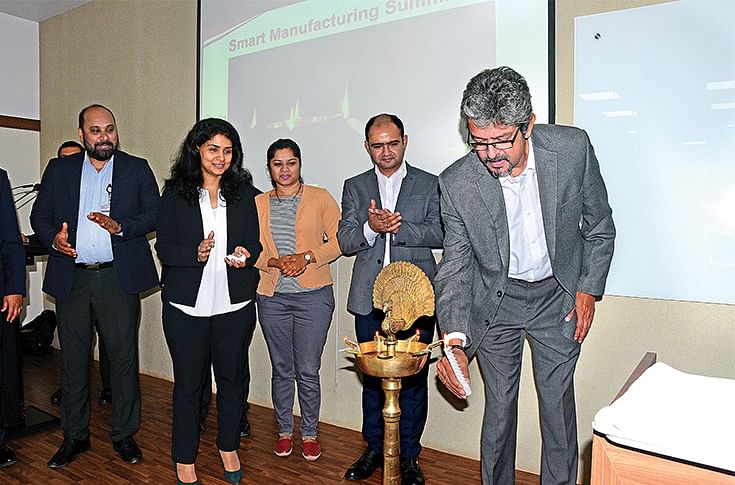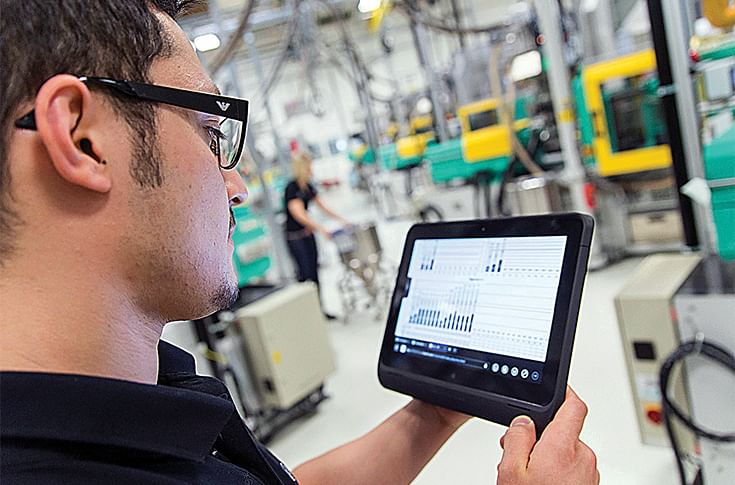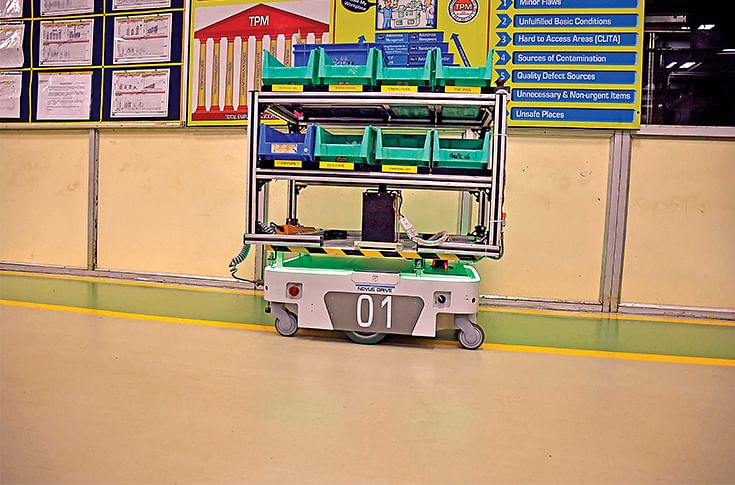How Industry 4.0 can power India Auto Inc's global competitiveness
A Confederation of Indian Industry-organised conclave on smart manufacturing sees automotive experts debate how Industry 4.0 can help enhance overall efficiencies and deliver across-the-board gains, so essential if an automaker is to advance in the global arena.
M&M's Igatpuri plant, which produces 1,286 engines every day, is India's first carbon-neutral manufacturing facility. Smart manufacturing methods, as well as energy efficiency measures, have helped achieve considerable productivity gains as well as cost savings
Even as the prolonged slowdown in the Indian automobile industry continues to vex stakeholders, it seems the development has led to faster adoption of smart manufacturing so as to improve overall efficiencies and deliver across-the-board gains.
With an intent to take this collaboration on a broader canvas, trade body Confederation of Indian Industry (CII), with support from Mahindra & Mahindra (M&M) organised a ‘Smart Manufacturing’ summit at Igatpuri, at the M&M plant, on September 23. Industry 4.0, Internet of Things (IoT), predictive machine maintenance, CBM, quality data management system and traceability, machine learning, artificial intelligence, data analytics and real-time safety monitoring were some of the subjects that were intensely discussed topics.
According to CII, a task force comprising senior industry professionals conducted a comprehensive study of prevailing and emerging manufacturing practices in India and globally. The council adopted the concepts for developing end-to-end assessment criteria with specific focus on applicability to MSMEs. The model encourages the organisations to determine its current state with respect to the level of industrialisation and to set a goal state (Industry 1.0 to 4.0). The subsequent questions on leadership and strategy probe the organisation’s approach to reach the goal state through management, resource and financial planning, and effective communication. Supplementary guidelines are being developed for on-site assessment by independent assessment teams and on-site assessments is expected to be launched by early 2020.
Why now is the time
According to Vijay Kalra (pictured below), chief of manufacturing, automotive division, Mahindra & Mahindra, the business environment has changed globally and the company's expertise in one area will not allow it to survive. “You have to collaborate,” said Kalra. “Now, if we don’t do it, very clearly we will be left behind by somebody else,” Kalra opined. He claims that the ongoing slowdown is the right time to move towards Industry 4.0. “When things are bad, it is time to look back and see what can be done differently,” he added.

Industry experts emphasised that traditionally, industry followed the past in order to devise solutions for the future. However, with connected technologies, which are increasingly getting adopted, decision making has now become real-time. Collaboration between OEMs, suppliers, dealers as well as customers on a single platform will help reduce operation overheads, transport costs, product rejection and maintenance costs, depending upon the kind of initiative a foresighted company takes.
Explaining his observations about adopting Industry 4.0 tools in India, Sanjeev Kumar Singh, vice-president, powertrain solutions (Nashik Plant), Head - Common Rail Injectors Manufacturing, Bosch, said that during his visits to some MSME component suppliers, he found that the rate of adoption of Industry 4.0 or connected machines is high, which is contradictory to normal perception. “If I put it that way, then the (adoption) is even better than any of the big companies,” said Singh, adding that India needs to grow at a fast pace, which can be done by utilising resources more efficiently and that is just what is happening.
Talking about the apprehensions about misuse or theft of data sharing between different stakeholders on a platform, the experts at the day-long event were of the consensus that the fear is unfounded. Also, it will not be possible to successfully bring flexibility and efficiency without the use of technology and hence, India Auto Inc should not miss the Industry 4.0 bus.
Digitalisation as a tool to drive global growth
Industry 4.0, which represents the fourth industrial revolution, is said to have begun with the digitisation of manufacturing, whereby machines get connected with each other. The first industrial revolution happened with the mechanisation of water steam, followed by mass-scale production of products in the second phase. The third revolution saw the surge of computers and their related activities.

RR Dasgupta, Chief Digital Officer, Microsoft Corp (India) lights the ceremonial lamp. To his right is Sanjeev Kumar Singh, VP - Powertrain Solutions (Nashik Plant), Head – Common-Rail Injectors Manufacturing, Bosch, at the Smart Manufacturing conclave
Adesh Muluk, deputy manager at Pune-based component firm Sogefi Engine System (India), said, “Every company should adopt Industry 4.0 but only as much as it needs. This will surely help in improving quality, productivity and introduce an effective work culture.”
Similarly, Amol Doshi, senior manager - Sales and Business Development at French supplier Valeo, said Industry 4.0 will help everybody in the long run. “It will help in exchanging industry's best practices with other players which will be beneficial for all.”
Smart manufacturing at M&M’s Igatpuri plant
Smart manufacturing has helped M&M’s Igatpuri plant improve its efficiency levels and also reduce its carbon and water footprint by 25 percent. Company executives said the plant has implemented cold testing of engines (derived from its synergy with Korean carmaker SsangYong) to reduce the engine cycle testing time. M&M has also managed to reduce its fuel consumption in the plant through smart arrangement of the factory floor and with the use of smart racks for carrying parts.
M&M deploys Hi-tech Robotics’ autonomous electric robot, which has dynamic obstacle detection and avoidance system, to transport necessary tools, kit and parts to workstations at Igatpuri plant
The Igatpuri plant has incorporated an autonomous electric robot from Pune-based automation solution company, Hi-tech Robotics (the same company that showcased the Automated Guided Vehicle at the 2016 Auto Expo). The robot is equipped with laser-based natural navigation that does not require any modifications to the existing infrastructure.
Industry 4.0 at India Auto Show, Mumbai
The Centre for Industry 4.0, an industry body set up by the Department of Heavy Industries under SAMARTH Udyog (Smart Automated Manufacturing and Rapid Transformation Hub) for sustainable growth of the Indian economy, says the manufacturing sector needs to contribute significantly. The Centre has set an ambitious target to increase the contribution of manufacturing from the current level of 16 percent to 25 percent of GDP by 2022 and to create 100 million jobs. Cyber-physical systems are leading the manufacturing industry into the fourth industrial revolution popularly known as Industry 4.0. It has the potential to address many challenges faced by Indian industry that hinder its global competitiveness. These include perception of low quality, stiff competition on cost from other nations, low levels of innovation and limited agility to meet rapidly changing customer needs.

Digitalisation helps streamline processes, increase quality, create new revenue streams, and reduce production costs. Contrary to perception, a fair number of MSMEs are taking to Industry 4.0 in India, says CII
Speaking at the India Auto Show, Dr Ravi Damodaran, CTO, Greaves Cotton, while making a presentation on the subject, said that Industry 4.0 can be a vital tool for India to stand up and be counted as a technology leader. For too long has the country been counted for its low technology, low productivity and low value products while still importing high-value products. In comparison, companies operating in matured markets like US, Japan and Europe have been innovating to stay relevant. Damodaran pointd out that Industry 4.0 can be used for two things — to eliminate waste from the system and to leapfrog manufacturing. “It means you can become competitive not only in India but around the world too,” he signed off, on a confident note.
(This article was first published in the October 15, 2019 issue of Autocar Professional)
RELATED ARTICLES
How Greater Consumer Responsiveness Helped Indian Brands Overtake Global Giants
Once overshadowed by global brands, Indian carmakers now lead the charge in SUVs, EVs, and safety.
From Rs 431 Crore Loss to Recovery: Inside TIL’s Comeback
New ownership charts ambitious turnaround for TIL, India's oldest crane manufacturer.
Why Toyota Is Building Its Carbon-Neutral Future Around India
A look inside the engineering logic driving the world’s largest carmaker as it pursues multiple routes to decarbonisatio...






 27 Dec 2019
27 Dec 2019
 15140 Views
15140 Views






 Prerna Lidhoo
Prerna Lidhoo


 Shahkar Abidi
Shahkar Abidi


